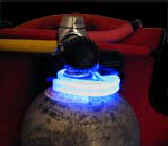Introduction
Chemiluminescence requires a combination of two special kinds of
chemistry. The first is called fluorescence. In fluorescence, a molecule absorbs
light to become excited state as a product of a chemical reaction. After a
lifetime - as short as 1 billionth of a second - the energetic excited state
releases its energy as light.
 The second and more unusual kind of chemistry
required is, of course, the chemical reaction that produces the excited state.
This is called the excitation process and is the real key to chemiluminescence.
We now know that certain decomposition reaction of organic peroxides can produce
excited products efficiently. In addition to substantial instantaneous energy
release and the formation of a fluorescent product, other more subtle
requirements must be met which involve the distribution of energy released from
a reaction between light emitting (or electronic) excited states and heat
emitting (or vibrational) excited states.
The second and more unusual kind of chemistry
required is, of course, the chemical reaction that produces the excited state.
This is called the excitation process and is the real key to chemiluminescence.
We now know that certain decomposition reaction of organic peroxides can produce
excited products efficiently. In addition to substantial instantaneous energy
release and the formation of a fluorescent product, other more subtle
requirements must be met which involve the distribution of energy released from
a reaction between light emitting (or electronic) excited states and heat
emitting (or vibrational) excited states.
 The second and more unusual kind of chemistry
required is, of course, the chemical reaction that produces the excited state.
This is called the excitation process and is the real key to chemiluminescence.
We now know that certain decomposition reaction of organic peroxides can produce
excited products efficiently. In addition to substantial instantaneous energy
release and the formation of a fluorescent product, other more subtle
requirements must be met which involve the distribution of energy released from
a reaction between light emitting (or electronic) excited states and heat
emitting (or vibrational) excited states.
The second and more unusual kind of chemistry
required is, of course, the chemical reaction that produces the excited state.
This is called the excitation process and is the real key to chemiluminescence.
We now know that certain decomposition reaction of organic peroxides can produce
excited products efficiently. In addition to substantial instantaneous energy
release and the formation of a fluorescent product, other more subtle
requirements must be met which involve the distribution of energy released from
a reaction between light emitting (or electronic) excited states and heat
emitting (or vibrational) excited states.